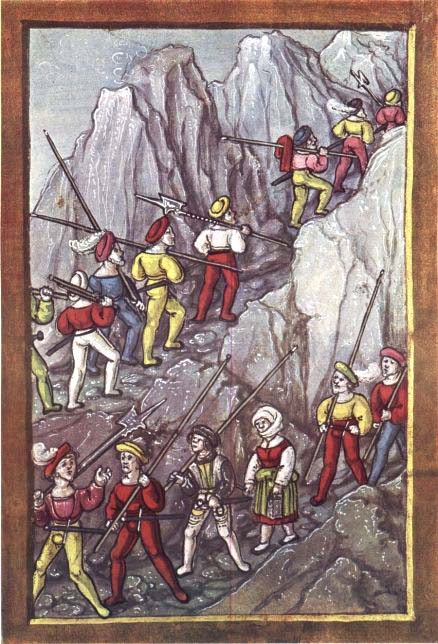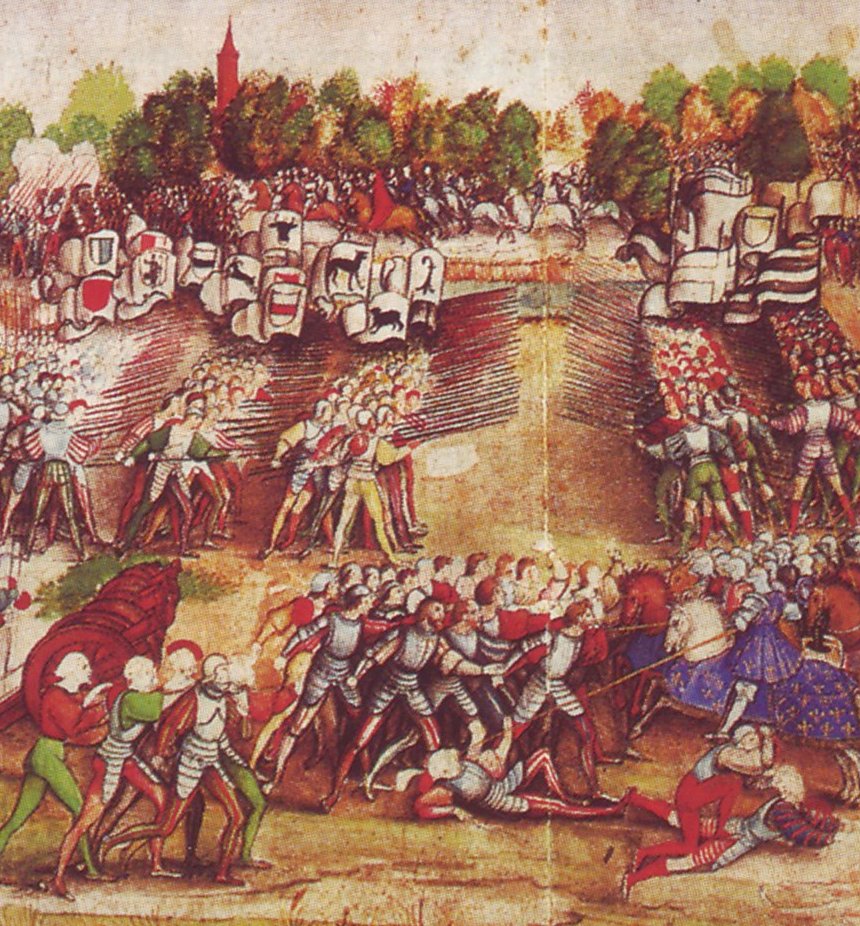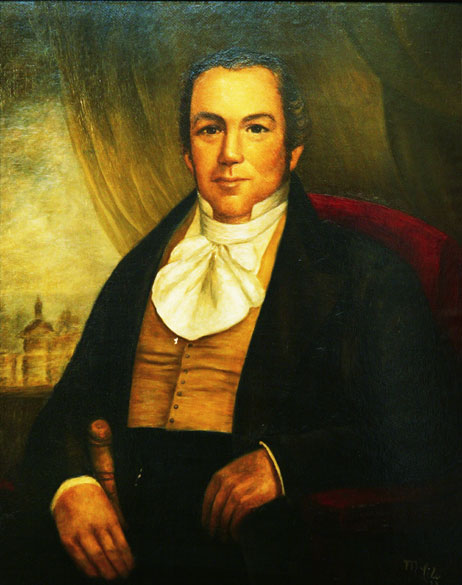|
Louis De Watteville
Louis de Watteville (born Abraham Ludwig Karl von Wattenwyl; 1 July 1776 – 16 June 1836) was a Swiss mercenary in Dutch and British service. He became a major general in the British Army, and fought in the Napoleonic Wars and the War of 1812. Early life and career Watteville was born in Grandson, Switzerland to David Salomon von Wattenwyl and Elisabeth Magdalena Jenner, and first served as a mercenary in the Netherlands. In 1801 he took over the command of De Watteville's Regiment from his uncle, Franz Friedrich von Wattenwyl. The regiment entered British service, and de Watteville fought with it in the French campaign in Egypt and Syria. Napoleonic Wars Louis fought with the regiment at the Battle of Maida, in 1806, and at the Siege of Cádiz. He was appointed Colonel of his regiment in 1812. In the following year, he and the regiment were transferred from Cádiz to Upper Canada. By this time the regiment was a mixture of nationalities, including German, Italian and Hungaria ... [...More Info...] [...Related Items...] OR: [Wikipedia] [Google] [Baidu] |
Swiss Mercenary
The Swiss mercenaries (german: Reisläufer) were a powerful infantry force constituted by professional soldiers originating from the cantons of the Old Swiss Confederacy. They were notable for their service in foreign armies, especially among the military forces of the Kings of France, throughout the Early Modern period of European history, from the Late Middle Ages into the Renaissance. Their service as mercenaries was at its peak during the Renaissance, when their proven battlefield capabilities made them sought-after mercenary troops. There followed a period of decline, as technological and organizational advances counteracted the Swiss' advantages. Switzerland's military isolationism largely put an end to organized mercenary activity; the principal remnant of the practice is the Pontifical Swiss Guard at the Vatican. Ascendancy During the Late Middle Ages, mercenary forces grew in importance in Europe, as veterans from the Hundred Years War (1337–1453) and other ... [...More Info...] [...Related Items...] OR: [Wikipedia] [Google] [Baidu] |
Battle Of Chateauguay
The Battle of the Chateauguay was an engagement of the War of 1812. On 26 October 1813, a combined British and Canadian force consisting of 1,530 regulars, volunteers, militia and Mohawk warriors from Lower Canada, commanded by Charles de Salaberry, repelled an American force of about 2,600 regulars which was attempting to invade Lower Canada and ultimately attack Montreal. The Battle of the Chateauguay was one of the two battles (the other being the Battle of Crysler's Farm) which caused the Americans to abandon the Saint Lawrence Campaign, their major strategic effort in the autumn of 1813. Prelude American plan Late in 1813, United States Secretary of War John Armstrong devised a plan to capture Montreal, which might have led to the conquest of all Upper Canada. Two divisions were involved. One would descend the St. Lawrence River from Sackett's Harbor on Lake Ontario, while the other would advance north from Plattsburgh on Lake Champlain. The two divisions would unite in ... [...More Info...] [...Related Items...] OR: [Wikipedia] [Google] [Baidu] |
Swiss Mercenaries
The Swiss mercenaries (german: Reisläufer) were a powerful infantry force constituted by professional soldiers originating from the cantons of the Old Swiss Confederacy. They were notable for their service in foreign armies, especially among the military forces of the Kings of France, throughout the Early Modern period of European history, from the Late Middle Ages into the Renaissance. Their service as mercenaries was at its peak during the Renaissance, when their proven battlefield capabilities made them sought-after mercenary troops. There followed a period of decline, as technological and organizational advances counteracted the Swiss' advantages. Switzerland's military isolationism largely put an end to organized mercenary activity; the principal remnant of the practice is the Pontifical Swiss Guard at the Vatican. Ascendancy During the Late Middle Ages, mercenary forces grew in importance in Europe, as veterans from the Hundred Years War (1337–1453) and other confl ... [...More Info...] [...Related Items...] OR: [Wikipedia] [Google] [Baidu] |
1836 Deaths
Events January–March * January 1 – Queen Maria II of Portugal marries Ferdinand II of Portugal, Prince Ferdinand Augustus Francis Anthony of Saxe-Coburg-Gotha. * January 5 – Davy Crockett arrives in Texas. * January 12 ** , with Charles Darwin on board, reaches Sydney. ** Will County, Illinois, is formed. * February 8 – London and Greenwich Railway opens its first section, the first railway in London, England. * February 16 – A fire at the Lahaman Theatre in Saint Petersburg kills 126 people."Fires, Great", in ''The Insurance Cyclopeadia: Being an Historical Treasury of Events and Circumstances Connected with the Origin and Progress of Insurance'', Cornelius Walford, ed. (C. and E. Layton, 1876) p76 * February 23 – Texas Revolution: The Battle of the Alamo begins, with an American settler army surrounded by the Mexican Army, under Antonio López de Santa Anna, Santa Anna. * February 25 – Samuel Colt receives a United States patent for the Colt Firearms, Colt ... [...More Info...] [...Related Items...] OR: [Wikipedia] [Google] [Baidu] |
1776 Births
Events January–February * January 1 – American Revolutionary War – Burning of Norfolk: The town of Norfolk, Virginia is destroyed, by the combined actions of the British Royal Navy and occupying Patriot forces. * January 10 – American Revolution – Thomas Paine publishes his pamphlet ''Common Sense'', arguing for independence from British rule in the Thirteen Colonies. * January 20 – American Revolution – South Carolina Loyalists led by Robert Cunningham sign a petition from prison, agreeing to all demands for peace by the formed state government of South Carolina. * January 24 – American Revolution – Henry Knox arrives at Cambridge, Massachusetts, with the artillery that he has transported from Fort Ticonderoga. * February 17 – Edward Gibbon publishes the first volume of ''The History of the Decline and Fall of the Roman Empire''. * February 27 – American Revolution – Battle of Moore's Creek Bridge: ... [...More Info...] [...Related Items...] OR: [Wikipedia] [Google] [Baidu] |
Grand Council Of Bern
The Grand Council (german: Grosser Rat, french: Grand conseil) is the parliament of the Swiss canton of Bern. It consists of 160 members (as of 2006) elected by proportional representation for a four-year term of office. The French-speaking part of the canton, the Bernese Jura (districts of Courtelary, La Neuveville and Moutier) has 12 seats guaranteed, and 3 seats are guaranteed for the French-speaking minority of the bilingual district of Biel/Bienne. Election The council is re-elected every four years. Like other legislatures in Switzerland, elections use party list proportional representation. There are nine constituencies, based on the districts of the Canton. Composition The last election was held in 2018. References * External links All links are in German and French, unless otherwise noted. Official website of the Grand Council of Bern* German-language Wikipedia article on the Grand Council of Bern * Websites for th2002an2006Grand Council elections {{Poli ... [...More Info...] [...Related Items...] OR: [Wikipedia] [Google] [Baidu] |
Rubigen
Rubigen is a municipality in the Bern-Mittelland administrative district in the canton of Bern in Switzerland. History Rubigen is first mentioned in 1267 as ''Rubingen''. The oldest traces of a settlement in the area include scattered neolithic and Bronze Age items and La Tene tombs. The remains of a Roman era fountain and an early medieval cemetery have also been found. During the Middle Ages, the village was part of the '' Herrschaft'' of Münsingen. The rulers of Münsingen built a fort near the village around 1278. Very little is known of the history of the fort, but it fell into ruins was demolished in 1798. During the 15th century, the village broke away from the Herrschaft and in the following century it became subject to the city of Bern. Due to its proximity to the city Bernese patricians built their summer homes in the area. The hamlet of Beitenwil was first mentioned in 1328 as ''Beitenwile''. It was originally owned by Fraubrunnen Abbey. However, in 1473, it was a ... [...More Info...] [...Related Items...] OR: [Wikipedia] [Google] [Baidu] |
Henry Procter (British Army Officer)
Henry Patrick Procter or Proctor (1763–31 October 1822) was a British major-general who served in Canada during the War of 1812. He is best known as the commander who was decisively defeated in 1813 by the Americans and left western Upper Canada in American hands. Procter is regarded by many as an inept leader who relied heavily on textbook procedure. His "going by the book" is attributed to his lack of any combat experience before coming to Canada. Early life Procter was born in Ireland. His father, Richard Procter, was a surgeon in the British Army. Henry Procter began his military career at the age of 18 as an ensign in the 43rd Regiment of Foot in April 1781. He served as a lieutenant in New York in the final months of the American War of Independence.Hyatt, ''Dictionary of Canadian Biography'' His promotion was slow, probably indicating a lack of means, since commissions were usually obtained by purchase. Procter became a captain in November 1792. He was promoted to ... [...More Info...] [...Related Items...] OR: [Wikipedia] [Google] [Baidu] |
Court Martial
A court-martial or court martial (plural ''courts-martial'' or ''courts martial'', as "martial" is a postpositive adjective) is a military court or a trial conducted in such a court. A court-martial is empowered to determine the guilt of members of the armed forces subject to military law, and, if the defendant is found guilty, to decide upon punishment. In addition, courts-martial may be used to try prisoners of war for war crimes. The Geneva Conventions require that POWs who are on trial for war crimes be subject to the same procedures as would be the holding military's own forces. Finally, courts-martial can be convened for other purposes, such as dealing with violations of martial law, and can involve civilian defendants. Most navies have a standard court-martial which convenes whenever a ship is lost; this does not presume that the captain is suspected of wrongdoing, but merely that the circumstances surrounding the loss of the ship be made part of the official record. ... [...More Info...] [...Related Items...] OR: [Wikipedia] [Google] [Baidu] |
Sortie
A sortie (from the French word meaning ''exit'' or from Latin root ''surgere'' meaning to "rise up") is a deployment or dispatch of one military unit, be it an aircraft, ship, or troops, from a strongpoint. The term originated in siege warfare. In aviation In military aviation, a sortie is a combat mission of an individual aircraft, starting when the aircraft takes off. For example, one mission involving six aircraft would tally six sorties. The sortie rate is the number of sorties that a given unit can support in a given time. In siege warfare In siege warfare, the word ''sortie'' refers specifically to a sudden issuing of troops against the enemy from a defensive position—that is, an attack launched against the besiegers by the defenders. If the sortie is through a sally port, the verb ''to sally'' may be used interchangeably with ''to sortie''. Purposes of sorties include harassment of enemy troops, destruction of siege weaponry and engineering works, joining the relief ... [...More Info...] [...Related Items...] OR: [Wikipedia] [Google] [Baidu] |
Siege Of Fort Erie
The siege of Fort Erie, also known as the Battle of Erie, from 4 August to 21 September 1814, was one of the last engagements of the War of 1812, between British and American forces. It took place during the Niagara campaign, and the Americans successfully defended Fort Erie against a British army. During the siege, the British suffered high casualties in a failed storming attempt; they also suffered casualties from sickness and exposure in their rough encampments. Unaware that the British were about to abandon the siege, the American garrison launched a sortie to destroy the British siege batteries, during which both sides again suffered high losses. After the British abandoned the siege, the reinforced American army followed up cautiously and forced a second retreat at Cook's Mills but, with the onset of winter and shortage of supplies, they withdrew. They demolished Fort Erie before leaving the area. The attempted siege ended one of the last British offensives along the northe ... [...More Info...] [...Related Items...] OR: [Wikipedia] [Google] [Baidu] |
Battle Of Lundy's Lane
The Battle of Lundy's Lane, also known as the Battle of Niagara, was a battle fought on 25 July 1814, during the War of 1812, between an invading American army and a British and Canadian army near present-day Niagara Falls, Ontario. It was one of the bloodiest battles of the war, and one of the deadliest battles ever fought in Canada, with over 1,731 casualties including 258 killed. The two armies fought each other to a stalemate; neither side held firm control of the field following the engagement. However, the casualties suffered by the Americans precipitated their withdrawal, and the British held the strategic initiative. Background On 3 July 1814 an American army under Major General Jacob Brown launched an attack across the Niagara River near its source on Lake Erie. His force quickly captured the British position at Fort Erie and then advanced north. Two days later one of his two brigades of regular U.S. Infantry under Brigadier General Winfield Scott defeated a British f ... [...More Info...] [...Related Items...] OR: [Wikipedia] [Google] [Baidu] |



%2C_by_John_Trumbull.jpg)
_152.jpg)


